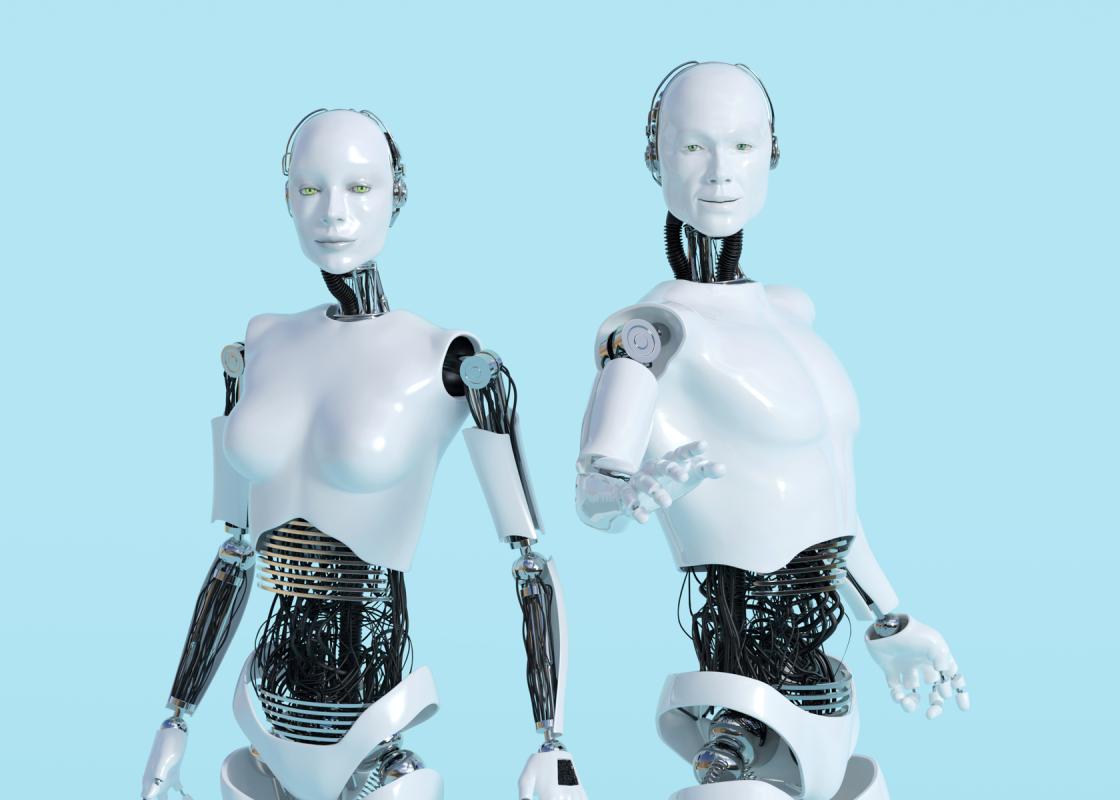Will they take our jobs? Will they become our new girlfriends and boyfriends? Robots and services based on artificial intelligence affect our work life and major parts of our everyday life while we hardly notice it. Technology consists of seemingly lifeless, material things. But do machines also have a gendered life?
“The way we understand robots’ gender is tied to how we understand human gender,” Roger Andre Søraa explains. He is a researcher at Department of Interdisciplinary Studies of Culture at Norwegian University of Science and Technology (NTNU), and chief investigator of the robot research project My Robot Friend.
We humans have an urge to give personality to non-human objects.
In his research, Søraa seeks to demonstrate that there is a connection between gender in society and gender in technology.
“We humans have an urge to give personality to non-human objects. For instance, many people give their boats, or their robot vacuum cleaners, female names. Gender is one of the first characteristics we assign to objects and humans.”
Robot, not human
Robots may be self-driving cars, vacuum cleaners, or it may be virtual assistants helping you through the day by checking your calendar, putting on a song on Spotify or doing your google search for you. There are several ways of gendering these robots.
“One example is to provide the technology with a high-pitched voice,” says Søraa.
Think about Apple’s Siri, or the now discontinued phone service Frøken Ur (the Speaking Clock). These are just some examples of services with a soft female voice.

Petter Bae Brandtzæg is associate professor at Department of Media and Communication at University of Oslo, and chief scientist at Sintef. He investigates chat services for teenagers within the project SocialHealthBots. They have chosen not to give gender to the chatbot they are currently developing.
“Many call their chatbot Kari or Jonas. We use the term ungbot (‘youngbot’), in order to consciously communicate theme rather than gender.”
According to Brandtzæg, teenagers who have tested the service find it sensible.
“They will know for certain that they are communicating with a robot and not a human being.”
Within robot research, they say they don’t want to enter an uncanny valley.
“When you enter an uncanny valley, you get a creepy feeling and become insecure. Technology becomes too humanised.”
According to Roger Andre Søraa, the creators of robots have followed the uncanny valley theory for decades.
“Even though you create a human-like robot, they will never be completely alike. If you are fooled into believing that the robot is a human being, but the voice or behaviour reveal that it is not, people may get scared. According to the theory, you should not take it too far.”
There are several examples of human-like robots, also referred to as androids or humanoids. It is essential for Søraa that the development of such robots generates thorough discussions. For how do we design the human? Here, Søraa emphasises that ideas about gender, class, race, and sexuality are important, and he goes on to ask:
“Do we wish to reproduce already existing ideas about gender?”
Shaped by society
Gender researchers have been interested in the relation between humans and technology for a long time. Professor emerita Merete Lie has worked on how humans curb technology, and how it, in turn, affects people. She explored this already in 1996 together with Knut Holtan Sørensen, in their book Making technology our own? Domesticating technology into everyday life. In an interview with Kilden from 2003, Lie commented on the relationship between technology and gender:

“The gender of material objects lies in their context and the way in which we perceive them. We say that things have gender. Things do not have gender as such, but our gaze is gendered.”
Roger Andre Søraa emphasises that although the robot technology is relatively new, humans relate to it in the same way as to other material objects.
“The difference is that the robots are so much more human-like than other technology.”
How a robot looks and works depends on the social context in which it is produced.
“For instance, if you grow up with women in the kitchen, that will be reflected in what you create. A robot produced in Japan will be different than one produced and used in the USA.”
The robots will reflect society’s gender roles, but they will also contribute to the shaping of gender roles.
“If we associate the female voice with service, we perhaps expect service from people with the same kind of voices. When the way in which technology speaks to us becomes more diverse, this will affect how people think about technology, but also the way we think about people.”
A gender transgressing android
Robots may have female or male characteristics, but some also exceeds traditional ideas about gender. When Søraa lived and worked in Japan, he soon became aware of a popular comedian called Matsuko, and his robot version: Matsukoroid.
“The human being Matsuko is a biological male who has chosen to present himself as a woman. He refers to himself as a male crossdresser, or drag queen,” he explains.
Matsukoroid, the robot copy of the comedian, looks exactly the same.
“But is the robot female or male? Perhaps it has a gender identity that is in flux, or is it queer? After all it doesn’t have any sexuality, but it is appropriate to ask many such questions,” says Søraa.
If we consider how a robot would have behaved, we begin to ask funny questions about how we gender ourselves and others.
The robot has become equally popular as the original. It even has its own talk show.
“This is very typical Japanese. Japan is very ahead on technological development, and has an open approach to whom they ‘clone’.”
“Do robots who play around with gender roles have a potential to challenge attitudes toward LGBT people, for example?”
“Yes and no. There is a risk that LGBT people are reduced to comic elements. Fortunately, Japan has improved queer rights. But they do have a somewhat conservative view on gender. This affects what kinds of robots they produce.”
View a video about matsuko-roid:
New perspective on gender identity
Within gender research, it has been common to distinguish between biological and social gender, and psychological gender – which is related to gender identity.
“Robots cannot have biological gender. You may install copies of human sexual organs, but they are mechanical, not biological,” says Søraa.
The robot’s physical features are significant for its social gender.
“When a robot is given male features such as broad shoulders or a beard, we will gender it socially as masculine. Because this is how we gender people.”
In addition, psychological gender is particularly important in order to understand gender identity – how you feel as either man or woman. What happens to gender identity in robots, who do not have feelings?
“I think this is the most interesting part. You may give the robot a high-pitched or a low-pitched voice. But is it then gendered? How do you programme a robot to believe that it is a woman in her fifties?”
Again, Søraa emphasises that society’s gender roles has strong constraints.
“If you imagine that the robot was developed in the 1950s, what would it have done? Would it have held the doors open? Whom would it have hugged, and how would it have placed itself in a room? If we consider how a robot would have behaved, we begin to ask funny questions about how we gender ourselves and others. After all, we do have a highly gender divided society.”
Big data miss nuances
Like us humans, robots create gender stereotypes when they interpret society, according to Petter Bae Brandtzæg.
In order for services such as chatbots or robots to work smart, they use artificial intelligence. This type of intelligence is developed by presenting them to big data – that is a lot of information.
“Big data comes from you and me and what we do on the internet. And there are already gender differences on the internet,” says Brandtzæg.
You have to be conscious of gender bias in technology in order to avoid that machines contribute to the preservation of the patriarchy.
In his research project, he and his colleagues use data from the website ung.no (‘young.no’).
“It is anonymised, but tagged with gender and age. We can observe that girls ask about one thing and boys about something else. At the same time, this is not absolute. But our machine learns from the general differences. Thus one can imagine that stereotypes are strengthened.”
“Is this necessarily a negative thing?”
“It may be a problem that we need to take into consideration. If the machine understands that a question comes from a girl of thirteen, it will tune into what girls of thirteen are normally interested in. But it does not catch all the nuances.”
Male dominated development
If you take a look at the workplaces in which artificial intelligence and robots are developed, most of the employees are male. This also applies to education and research on the field. Brandtzæg believes that the uneven gender balance affects technology, and that more people ought to consider what consequences unconscious prejudices and ideas about gender, so-called gender bias, may have.
“The result depends on who codes the machines and how it is coded. Will the developers take gender differences into consideration, or will they try to counteract them? You have to be conscious of gender bias in technology in order to avoid that machines contribute to the preservation of the patriarchy.”
Researchers disagree whether porn and sex robots provoke a need in boys and men, or whether the robots meet already existing needs.
Why is that? Should the robots be normative?”
“We imagine that artificial intelligence will solve the challenges of the future. It is supposed to be the cornerstone technology within sectors such as health, finance, and administration. Therefore, we need to aim for neutral systems. But the systems must also adjust to gender.”
He points to Danah Boyd’s research. She has documented how VR technology, that is technology that allows the user to experience a virtual reality, made female users nauseous. The same finding has been documented by Norwegian researchers. The technology was developed by men and tested on men. Thus, the fact that women became nauseous was not detected during the development process.
Robot or au pair
In popular culture, the relation between humans and technology is a widely explored topic. The TV series Black Mirror, which shows how human beings behave in a high-tech society in the near future or the feature film Her, in which a man develops a love relationship with an operative system with Scarlet Johansen’s soft voice, are two examples.

Julianne Yang is a media researcher at University of Oslo, and has studied how such relations are explored in the Swedish TV series ‘Real Humans’ from 2012. Here, the robots, or hubots as they are called, are created as so much alike real humans that it is difficult to distinguish between them.
“The fact that they are so alike humans invites the viewers to interpret them as symbols of humans in society today,” she says.
In the series, it is particularly the roles as housemaid and sex partner that is filled by robots. We meet the family of Inger Engman, a successful lawyer with three children. She struggles to make ends meet in a busy life, and chooses to purchase a hubot to combat the time squeeze.
“The series uses the science fiction genre to demonstrate that we have an equality ideal in Scandinavia, but that it is difficult to find the right balance in people’s homes. The technology that is on its way will make this conflict even more relevant. It will possibly solve some problems, but create others,” says Yang.
The robot does not get angry or exhausted. It needs to be charged every now and then, but it is always calm and present.
The lifeless robots provoke very human emotions.
“They trigger a fear of losing the things we value. A fear that they will take our jobs, but also that we might lose intimacy with family members. Inger feels a discomfort related to her being privileged, particularly when the hubot carries out tasks that she and her husband have done previously. She doesn’t want the children to be spoiled.”
In the series, the android challenges the role of motherhood.
“Inger’s time squeeze is solved, but she feels that she is becoming a bad mother. The robot does not get angry or exhausted. It needs to be charged every now and then, but it is always calm and present. A mother that is always present and never tired is unrealistic,” says Yang.
The sex robots are coming
In 2010, Douglas Hines launched his latest invention: the sex robot Roxxy. According to Hines, the robot could listen, talk, respond to physical contact and have orgasms. In the series Real Humans, too, robots have the role as sex partners. According to Yang, there are some ethical questions connected to the development of sex robots.
“It is worth asking whether they strengthen women’s unrealistic and stereotypical ideas of beauty,” she says.
Yang sees a clear parallel to the porn culture.
“Many of these robots look like small girls. Researchers disagree whether porn and sex robots provoke a need in boys and men, or whether the robots meet already existing needs.”
Can the robot solve the elder boom?
Intelligent technology may ease the workload in several sectors. In Norway, milking robots are in use within dairy farming, the robot Bagsy sorts waste for the municipalities, and robots are about to enter the daily operations of the health sector. In nursing homes across Norway, elderly people are being acquainted with the humanised robot Pepper and the robot seal Selma. Whereas Selma is an example of a so-called zoomorphic robot without gender, Pepper was created with a high-pitched voice.
“Although it was not gendered to begin with, in the West, many will gender it female. At NTNU, Pepper is used within research, and I hear that it is common to refer to it in male terms there. They often say things like ‘I saw him over there’.”
He rarely hears Pepper being referred to as ‘it’, without gender. According to Søraa, this has to do with our language.
“We are so used to operating with gender categories unless someone has expressed a clear wish of not being gendered.”
“You call for a different language for gender and technology – why?”
“I want us to reflect more upon how we talk about technology. That we are conscious of how we use and understand the technology in society, and that it affects us. This may give us a unique opportunity to explore our understanding of gender.”
Translated by Cathinka Dahl Hambro.
Read more:
Søraa, Roger Andre (2017): Mechanical genders: how do humans gender robots? i Gender, Technology and Development, 21:1-2.
Yang, Julianne Q.M. (2018): Negotiating privilege and social inequality in an alternative Sweden: Real Humans/Äkta Människor (SVT, 2012–2013) i Journal of Aesthetics and Culture 10:2.



